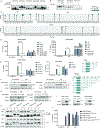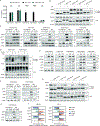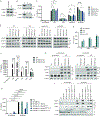pLxIS-containing domains are biochemically flexible regulators of interferons and metabolism
- PMID: 38925114
- PMCID: PMC11282577
- DOI: 10.1016/j.molcel.2024.05.030
pLxIS-containing domains are biochemically flexible regulators of interferons and metabolism
Abstract
Signal transduction proteins containing a pLxIS motif induce interferon (IFN) responses central to antiviral immunity. Apart from their established roles in activating the IFN regulator factor (IRF) transcription factors, the existence of additional pathways and functions associated with the pLxIS motif is unknown. Using a synthetic biology-based platform, we identified two orphan pLxIS-containing proteins that stimulate IFN responses independent of all known pattern-recognition receptor pathways. We further uncovered a diversity of pLxIS signaling mechanisms, where the pLxIS motif represents one component of a multi-motif signaling entity, which has variable functions in activating IRF3, the TRAF6 ubiquitin ligase, IκB kinases, mitogen-activated protein kinases, and metabolic activities. The most diverse pLxIS signaling mechanisms were associated with the highest antiviral activities in human cells. The flexibility of domains that regulate IFN signaling may explain their prevalence in nature.
Keywords: GMIP; IRSp53; MAVS; MyD88; STING; TASL; TBK1; TRAF6; TRIF; infection; interferon; macrophages; synthetic biology.
Copyright © 2024 Elsevier Inc. All rights reserved.
Conflict of interest statement
Declaration of interests J.C.K. consults and holds equity in Corner Therapeutics, Larkspur Biosciences, MindImmune Therapeutics, and Neumora Therapeutics. M.H. received research funding from Agilent Technologies and Roche Pharmaceuticals and is on advisory boards for Alixia, MitoQ, and Minovia. M.H. is on the advisory boards of Molecular Cell and Cell Metabolism.
Figures







References
MeSH terms
Substances
Grants and funding
LinkOut - more resources
Full Text Sources
Research Materials
Miscellaneous

